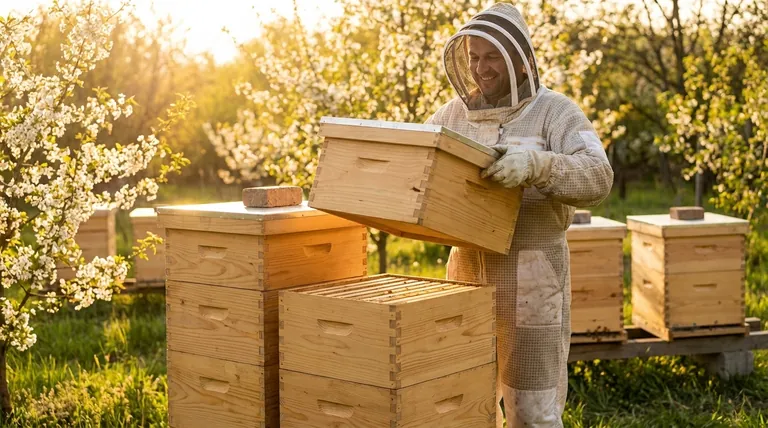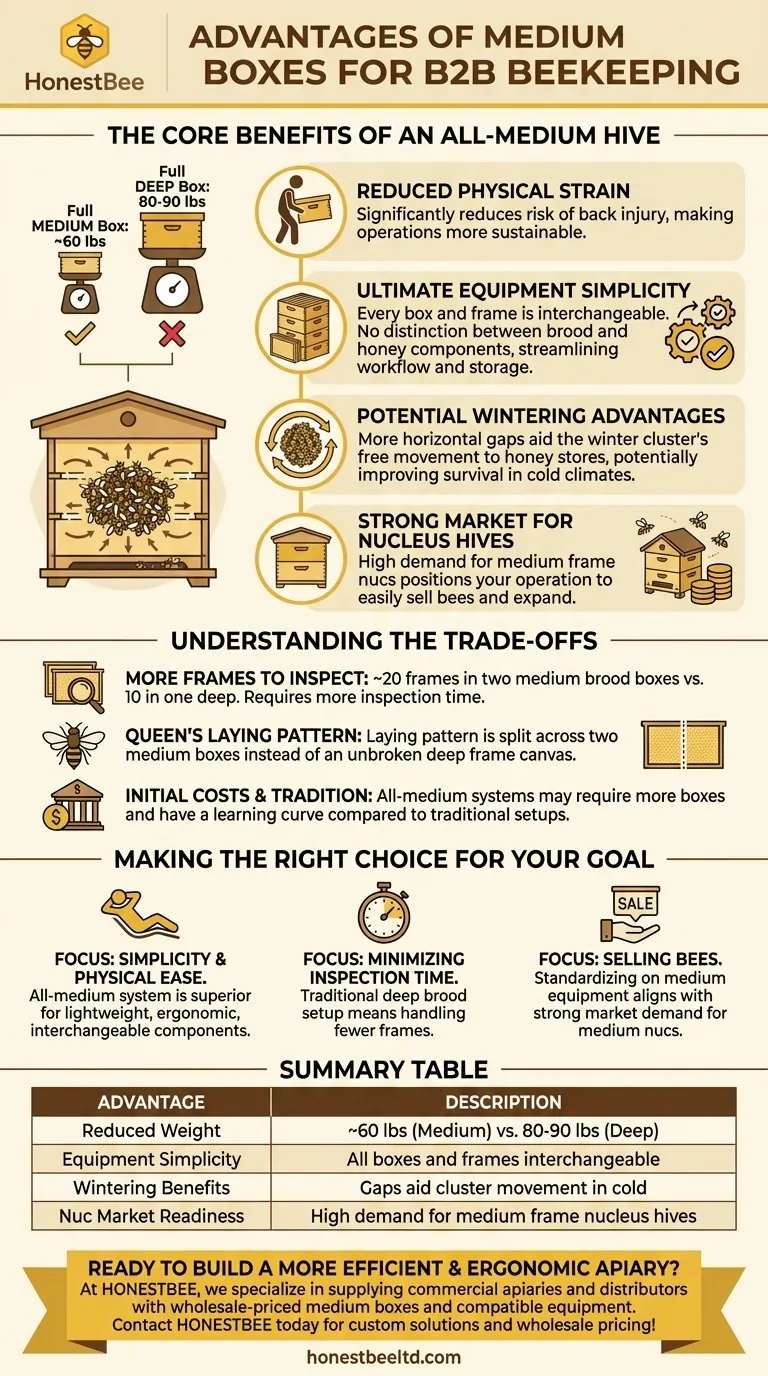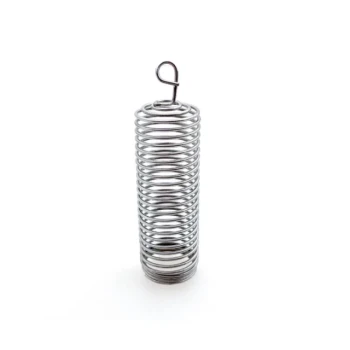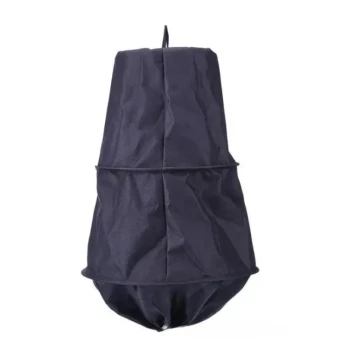In beekeeping, the primary advantages of using medium-sized boxes are a significant reduction in weight, the simplification of equipment management, and increased flexibility in hive configuration. This makes them an excellent choice for beekeepers who prioritize ergonomics and operational simplicity, as a full medium box weighs around 60 pounds, compared to the 80-90 pounds of a deep box.
The decision to use medium boxes is fundamentally about standardizing your equipment for maximum simplicity and interchangeability. While it may mean handling more individual boxes, it eliminates the complexity of managing different-sized components for brood and honey.

The Core Benefits of an All-Medium Hive
Choosing to build your entire apiary with medium boxes offers several distinct operational advantages. This approach, where every box and frame is the same size, is often called "all-mediums."
Reduced Physical Strain
The most frequently cited benefit is weight. A full medium box, packed with honey, weighs approximately 60 pounds. In contrast, a deep box can easily exceed 80 or 90 pounds.
This difference is critical during inspections and honey harvesting, significantly reducing the risk of back injury and making the hobby more accessible and sustainable over the long term.
Ultimate Equipment Simplicity
When every box in your apiary is a medium, all your equipment becomes interchangeable. There is no distinction between a "brood box" and a "honey super."
This simplifies everything from hive inspections to storage. You never have to worry about whether you have the right size frame or box on hand, streamlining your entire workflow.
Potential Wintering Advantages
An all-medium configuration creates more horizontal gaps between boxes compared to a hive with deeps. This can be beneficial for the winter cluster.
These gaps allow the cluster of bees to move more freely between frames and up through the hive to reach their honey stores, which can improve their chances of survival in cold climates.
Strong Market for Nucleus Hives
If you plan to sell bees, there is a very high demand for nucleus hives (nucs) made with medium frames.
Standardizing on medium equipment from the start positions you perfectly to meet this market demand, providing a straightforward path to selling bees and expanding your operation.
Understanding the Trade-offs
While an all-medium system offers compelling benefits, it is not without its trade-offs when compared to the traditional setup of using deep boxes for brood and mediums for honey.
More Frames to Inspect
To provide the queen with adequate laying space, a brood chamber in an all-medium hive typically consists of two medium boxes. This means you will have 20 frames to inspect, compared to the 10 frames in a single deep brood box.
For beekeepers who want to minimize the time spent on each inspection, this is a significant consideration.
Queen's Laying Pattern
A single, large deep frame provides an uninterrupted canvas for the queen to lay her eggs. In a two-box medium brood chamber, her laying pattern is split across the boundary between the boxes.
While most queens adapt without issue, some beekeepers believe the unbroken space of a deep box is more natural and efficient for brood rearing.
Initial Costs and Tradition
A traditional hive setup with one deep and a few mediums can sometimes have a slightly lower initial cost than an all-medium hive that requires more boxes to achieve the same volume.
Furthermore, many experienced beekeepers are accustomed to the deep-box system, and most educational material is based on it, which can present a learning curve for new beekeepers choosing an alternative path.
Making the Right Choice for Your Goal
Your decision on hive equipment should be driven by your personal goals, physical capabilities, and management style.
- If your primary focus is simplicity and physical ease: An all-medium hive system is the superior choice for its lightweight, ergonomic, and fully interchangeable components.
- If your primary focus is minimizing hive inspection time: A traditional setup with deep brood boxes means you will handle fewer frames to check the health of the colony.
- If your primary focus is selling bees: Standardizing on medium equipment from the beginning aligns your operation with strong market demand for medium nucs.
Ultimately, choosing your hive equipment is about creating a system that works for you, ensuring that beekeeping remains an enjoyable and manageable endeavor.
Summary Table:
| Advantage | Description |
|---|---|
| Reduced Weight | A full medium box weighs ~60 lbs vs. 80-90 lbs for a deep box, reducing physical strain. |
| Equipment Simplicity | All boxes and frames are interchangeable, streamlining hive management and storage. |
| Wintering Benefits | More horizontal gaps aid the bee cluster's movement to honey stores in cold weather. |
| Nuc Market Readiness | High demand for nucleus hives built on medium frames creates a revenue opportunity. |
Ready to build a more efficient and ergonomic apiary?
At HONESTBEE, we specialize in supplying commercial apiaries and beekeeping equipment distributors with high-quality, wholesale-priced medium boxes and compatible equipment. Standardizing your operation with our all-medium systems will reduce physical strain on your team, simplify your inventory, and position you to capitalize on the strong market for medium nucs.
Let our experts help you configure the ideal setup for your goals. Contact HONESTBEE today for wholesale pricing and custom solutions.
Visual Guide

Related Products
- Australian Langstroth Beehive Boxes for Beekeeping Wholesales
- Langstroth Bee Hives Bee Keeping Box for Beginners Beekeeping
- Langstroth Honey Bee Box Hive Boxes for Different Depths
- Portable Bee Mating Hive Boxes Mini Mating Nucs 8 Frames for Queen Rearing
- HONESTBEE Professional Long Handled Hive Tool with Precision Cutting Blade
People Also Ask
- How many frames fit into a standard beehive box? Choose Between 8-Frame and 10-Frame Hives
- What are the sizes of supers available in a standard hive? A Guide to Deep, Medium, and Shallow Boxes
- What is the best hive for beginners? A Guide to Langstroth, Top Bar, and Flow Hives
- What are the three types of beehives? Find the Perfect Hive for Your Beekeeping Philosophy
- Why might a beginner be advised to start with a Langstroth hive? Unlock a Supportive Beekeeping Ecosystem



















